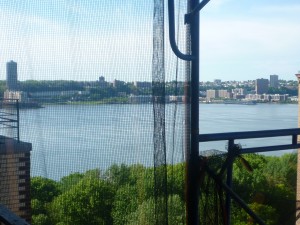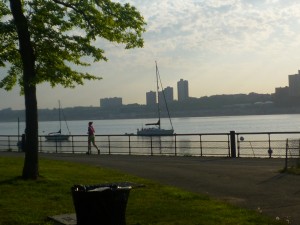Gentle Reader,
I am reducing my carbon foot print. My house is organized chaos. All the furnishings are stacked in the middle of each room, covered with sheets. Two young men are drilling holes in the outside walls of every room, caulking the heat registers, the joint where wall meets floor, and every nook where air can leak.
In Seattle we have an Energy Upgrade program to entice a home owner to do this. Over two thousand families have opted in, gotten their financing together, had the energy audit and done the work. The opportunity for low interest loans and government rebates may be extended if Cascadia Consulting, the small, forward reaching firm who operates this program can persuade the city to do another round, without Federal dollars.
What took me so long to sign up for this? I have a reputation as a carbon off-setter. I have bought shares in wind farms on the Lakota reservation. I have planted trees through Re-leaf America, the oldest environment organization in the US, founded in 1903. But my house was more of a tent with permanent walls, leaking air like a sieve.

After a recent trip to New York City with my granddaughter, I find myself reflecting on the actions of a single individual in the face of the enormity of the problem facing the world. We must get our carbon parts per million down to 350 or find ourselves in an irreversible environmental catastrophe. Compare the interest and effort in this far flung corner of the US with New York City.
My hostess, Mary Ann, lives in a beautiful rent controlled apartment on the Upper East Side, the Hudson River in full view from her spacious north facing balcony. The fine old metal and glass paneled windows do not latch. Walking along the path beside the river just 100 yards from her building’s front door, Ellie and I joined cyclists, mothers with baby carriages, old people leaning on canes, joggers, strollers. This is one New York’s back yard retreats.

The sun danced on the wavelets of a calm river. New green, that not-shiny-yet true green that appears miraculously every May after a hard winter of snow and bitter cold. This year in New York, they were locked in a cold that would not stop, seeping into bones and the cracks in all the houses.
I asked Mary Ann how she managed to stay warm in this 17th floor apartment with its rusty metal-framed windows.
“The heat in the building is so great; I have the windows open all winter.”
Can you believe it?
The carbon foot print of New York City by itself, if reduced by 15%, could turn 400 ppm to 380, I have no doubt. This is an emergency. Federal dollars could reverse the course of disaster by compulsory retrofitting every building in New York City, changing every light bulb. People would be put to work in the process.
It would be worth every penny. Repeat the process in Chicago, Detroit, Boston, and Gary, Indiana. Every major city where old high rises scrap the sky as wicks of heat pouring into the atmosphere.
I have learned in talking with my environmentalist daughter that NYC has excellent energy recovery projects underway. It is a huge job.
My little project will off-set the carbon foot print I create every time I get on an airplane for the next 10 years. It is a drop in the bucket. My visit to New York discourages me from the belief that we can save our planet for future generations.
What are you doing in your neck of the woods? Let us know, please.
By the way, are you reducing your carbon foot print by using highly concentrated, biodegradable cleaning and laundry products? Check them out on my shopping page. You’ll be so glad you did. You’ll throw away 1 bottle for every 50 of those other products.
Be Well, Do Well and Keep Moving, Betsy
ps: I made a video showing the energy upgrade project. You can see it on YouTube. <iframe width=”560″ height=”315″ src=”https://www.youtube.com/embed/ta1n0-YU9jI” frameborder=”0″ allowfullscreen></iframe>